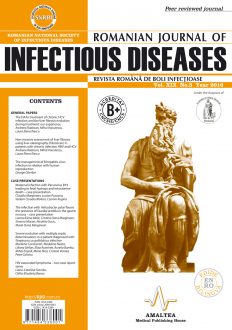SELECT ISSUE

Indexed

| |

|
|
|
| |
|
|
|

|
|
|
|
|
|
| |
|
|
HIGHLIGHTS
National Awards “Science and Research”
NEW! RJID has announced the annually National Award for "Science and Research" for the best scientific articles published throughout the year in the official journal.
Read the Recommendations for the Conduct, Reporting, Editing, and Publication of Scholarly work in Medical Journals.
The published medical research literature is a global public good. Medical journal editors have a social responsibility to promote global health by publishing, whenever possible, research that furthers health worldwide.
NON-INVASIVE ASSESSMENT OF LIVER FIBROSIS USING LIVER ELASTOGRAPHY (FIBROSCAN) IN PATIENTS WITH CHRONIC INFECTION HBV AND HCV
Andreea Rădășan, Mihai Voiculescu and Laura Elena Iliescu
ABSTRACT
Introduction. In recent years there have been major advances in the treatment and prevention of viral hepatitis, but this pathology is still a major health and socio-economic problem. The defining element for this disease is the liver fibrosis, a histological component of particular importance due to its role in the formation of liver lesions of cirrhosis. Thus, an essential step in the management of chronic viral hepatitis is the detection and measurement of liver fibrosis. Today we have invasive methods for detecting liver fibrosis, the liver puncture biopsy, and non-invasive methods, which in turn are divided into serum methods and imaging methods (2).
Purpose of the Study. The aim of this study is to determine if transcutaneous elastography (FibroScan) is equally reliable in case of viral hepatitis B, as with viral hepatitis C.
Material and Method: The study comprises a total of 1,127 patients with liver disease of HBV and HCV aetiology. These patients were examined using FibroScan in the period July 2009 - April 2011.
Results: Of the 1,177 patients investigated using FibroScan, 40 underwent liver biopsy as well. Of these, 82% have obtained same stages of liver fibrosis in these two investigations, and 18% achieved different stages of fibrosis in these two tests. For the patients with HCV infection, we obtained a 67.81% match of the two non-invasive tests, FibroScan and FibroMax, and a 79.16% match of FibroScan compared to the Liver Biopsy. For the B virus, the compliance is even better, of 75% (FibroScan - FibroMax), and 80% for FibroScan - LB.
Conclusions: FibroScan is one of the non-invasive assessment methods of liver fibrosis with diagnose accuracy similar to FibroMax and close to Liver Biopsy.
Keywords: Hepatitis B, Hepatitis C, FibroScan, FibroMax, Fibrosis, accuracy, match
Full text | PDF
